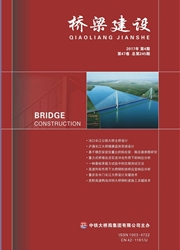

 中文摘要:
中文摘要:
为获得山区高速铁路圆端形空心高墩任意高度处的三维日照温度场及温度变形规律,以合福高铁南平建溪特大桥的68m圆端形空心高墩为例,通过建立高墩截面的二维温度场有限元模型,并采用三维插值算法将其拓展至三维温度计算模型,计算分析了高墩径向、竖向温度场,以及高墩在日照作用下的变形特征。结果表明:高墩在日照作用下,径向温度沿壁厚方向变化符合负指函数变化规律,日照温度影响深度约为0.60m;桥墩表面竖向温度符合负指数加线性函数变化规律;在日照作用下,墩顶最大水平位移和墩顶转角均发生在18:00左右,最大位移为12.9mm,最大转角为0.261‰rad,可取18:00左右的温度场作为控制荷载,对桥墩结构的变形进行检算。
 英文摘要:
英文摘要:
To acquire the three-dimensional solar radiation temperature fields and the tempera- ture deformation laws of the arbitrary height of the round end hollow tall pier for mountainous high-speed railway bridge, the 68 m high round end hollow tall pier of Nanping Jianxi River Bridge on Heifei-Fuzhou High-Speed Railway was taken as an example and by way of establishing the two-dimensional temperature field finite element model for the section of the pier and using the three-dimensional interpolation method, the finite element model was expanded into a three-dimen- sional temperature calculation model, the radial and vertical temperature fields and the deformation characteristics of the pier under the solar radiation were calculated and analyzed. The results of the calculation and analysis indicate that under the solar radiation, the changing of the radial tempera- tures along the direction of the wall thickness of the pier accords with the changing law of the neg- ative exponential function and the influenced depth of the solar radiation temperature is about 0. 60 m. The changing of the vertical temperatures on the surface of the pier accords with the changing laws of the negative exponential function and linear function. Under the solar radiation, the maximum horizontal displacement and the maximum rotation angle of the pier top all occur at about 18:00 hour, of which the maximum displacement is 12.9 mm and the maximum rotation angle is 0. 261‰ rad and the temperature fields of the pier at the 18:00 hour can be selected as the temperature control load for the checking calculation of the deformation of the pier structure.
 同期刊论文项目
同期刊论文项目
 同项目期刊论文
同项目期刊论文
 期刊信息
期刊信息
